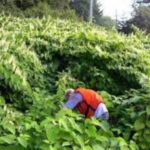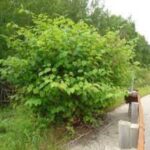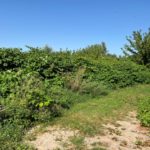Japanese Knotweed




Japanese Knotweed (Fallopia Japonica)
Japanese Knotweed is one of the most problematic invasive alien species and is an increasingly common sight on waste ground, the fringes of our waterways and roads and in our wetland habitats. Japanese knotweed can seriously damage buildings and infrastructure by growing through concrete, tarmac and other hard surfaces if any cracks exist. Japanese knotweed grows vigorously and out-competes native plants. It forms tall thickets up to 3 metres in height that exclude all other vegetation, shading the area below. The principal means of spread of Japanese knotweed is entirely through the deliberate or accidental movement of rhizome fragments or cut stems. Japanese knotweed has the extraordinary ability to spread and even tiny amounts of cut stem, crown or rhizome are capable of producing a new plant. Controlling spread is therefore dependent on preventing the spread of the stem, crown or rhizome. Landowners are being asked to be on the lookout for Japanese knotweed and cutting back or trimming of Japanese knotweed must be avoided.
Giant Hogweed

Giant Hogweed (Heracleum Mantegazzianum) is an invasive alien species (IAS) which comes from the Caucasus and was originally introduced into Ireland over 50 years ago as an ornamental. It grows huge, up to 5 metres tall, with rough serrated leaves one and a half metres wide, and large umbrella-like flowers that can yield many tens of thousands of viable seeds.
Giant Hogweed – Riverbank
Giant Hogweed is easy to identify when mature, but more difficult when young, click here. For tips on how to identify it at all stages of growth, and how to distinguish it from our native hogweed (Heracleum Sphondylium) and other similar native species, click here.
Ireland’s equable climate suits Giant Hogweed perfectly. It favours the damp, open margins of river banks where its seeds can readily disperse downstream but, increasingly, it is found at field boundaries, along road verges and in people’s gardens.
Giant Hogweed is regarded as one of the world’s worst invasive alien plants for the following reasons:
It produces a toxic sap in all parts of the plant which can cause a very serious burn that is known as a phytophotodermatitis because the sap is activated by light. Check out ways to stay safe, click here.
Its sheer size shades out smaller native plant species and eventually kills them. Because Giant Hogweed seeds are relatively heavy, they tend to fall within a few metres of the parent plant, and this leads to dense infestations of hundreds of plants across a small area.
There is increasing evidence that Giant Hogweed changes the chemical and metabolic status of soil it is growing in, making it inhospitable to native species.
In the winter it dies back. Because there is no native vegetation, soil is exposed and river banks become vulnerable to erosion.
One plant can produce a large number of seeds which can disperse downstream if the parent plant is near water. There is also evidence that Giant Hogweed seeds are being accidentally harvested with fodder crops, and may germinate at the location the fodder is taken to. This means that Giant Hogweed can be found in any location.
Ragwort

Ragwort (Senecio Jacobea) is also known as ragweed, Buachalán and Buachalán Buidhe. It is a common weed of Irish pastures and thrives on a wide range of soils, but competes best on lighter free draining soils where fertility is reasonably high and grazing not intensive. There are four main types of ragwort to be found in Ireland according to An Irish Flora (1996) namely:
Common Ragwort – Senecio Jacobaea – found everywhere
Marsh Ragwort – Senecio aquaticus – wet fields, marshes esp. western counties
Oxford Ragwort – Senecio squalidius – mainly in our larger cities, rare elsewhere
Hoary Ragwort – Senecio erucifolius – locally, Dublin, Meath
All four can interbreed where both parents are found.
During the Irish summer months with both warm and wet weather, it means everything around us is growing, including Ragwort. Ragwort is a common native wildflower (although some say a weed) that grows throughout Ireland and can be dangerous to animals if eaten. It is one of the most common causes of plant poisoning in equines. Ragwort can damage the liver which may result in severe disease and even death.
Why is Ragwort dangerous?
Ragwort contains toxins called pyrrolizidine alkaloids. These, in sufficient quantities, can cause liver poisoning in horses and livestock. It is a cumulative poison that eventually leads to the rapid onset of symptoms before death. However, symptoms are variable and resemble those of several other diseases.
The majority of horses won’t eat Ragwort straight away if it is growing among their grazing as it can taste bitter, however, this does not mean they won’t. Horses will also eat Ragwort if nothing else is available. When the plant wilts and dies, it loses its bitter taste and becomes palatable, but, it does not lose any of its toxicity and remains a danger.
Ref: ISPCA
